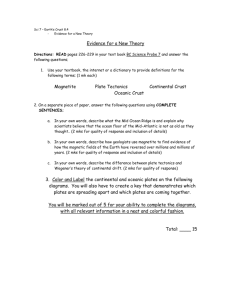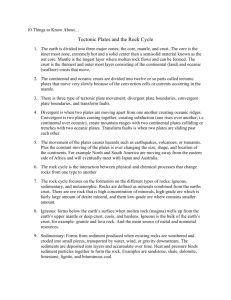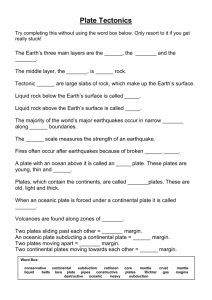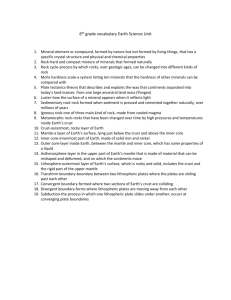Review for Placement Test 1
advertisement
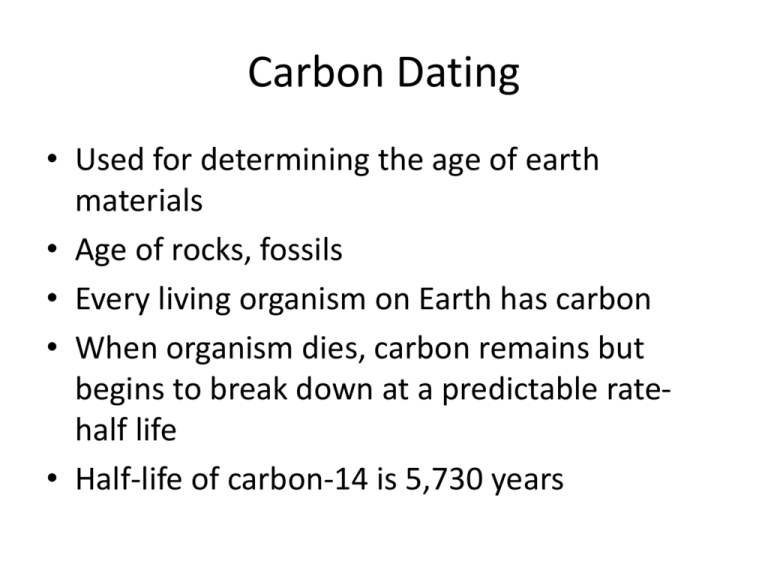
Carbon Dating • Used for determining the age of earth materials • Age of rocks, fossils • Every living organism on Earth has carbon • When organism dies, carbon remains but begins to break down at a predictable ratehalf life • Half-life of carbon-14 is 5,730 years How old is it? • Every 5,730 years the amount of carbon will reduce by half. • This means that no matter how old something is, the amount of carbon can get smaller and smaller but never go away. • If a fossil of a fish is found and scientists know it originally had 2g of carbon-14 and now only has 0.0625g, how old is it? • If carbon is in all living things, it is in rocks and soil- decomposition. • Carbon dating is used to help estimate the age of the earth • But the oldest rocks are usually located at the bottom of a rock profile. Why? Law of Superposition • Sediments or lava are deposited on top of the existing rocks or soil. • Those sediments are compacted to form new rock • New rock on top, old rock at bottom Exceptions to the Law of Superposition • Faulting • Non-deposition • Intrusion- injection of lava from the mantle • Which layer is the oldest? • Which is the youngest? Layers of the Earth • inner core - mass of solid iron with a temperature of 70000 F • outer core – liquid iron, responsible for our magnetic fields • mantle - slow moving molten rock or magma, 20000 F • crust - layer from 4-25 miles thick consisting of sand and rock But wait, There’s more! • Lithospherecrust and upper most part of mantle- tectonic plates move • Asthensopherebelow lithosphere, upper part of mantle Focus on the Mantle • Liquid rock • Heated by the core • Heat creates convection currents • Convection currents make tectonic plates move Mantle moves, Plates move Continental vs. Oceanic Plates • Continental crust is less dense than oceanic crust • When continental plate collides with oceanic plate, oceanic will go under the continental and oceanic plate is subducted or recycled back into the mantle. • ***See Plate Boundaries handout *** When Plates Collide • Convergent Boundarytwo continental plates collide forming mountains- Mt. Everest and Himalayan Mts • Subduction Zoneoceanic vs. continental or oceanic vs. oceanicRing of Fire, Mt. St. Helens, Mt. Vesuvius Pull Apart • Divergent Boundarytwo plates pull apart • Forms Mid-Ocean Ridges Mid-Atlantic RidgeIceland Volcano Sliding Past Each Other • Transform Boundary ↑↓- Creates Faults • Faults- cracks in the Earth where plates move past each other • San Andreas Fault, New Madrid Fault • EARTHQUAKES! Earthquake! • Fault- plate boundary • Focus- point inside the earth where earthquake begins • Epicenter- Point on SURFACE where earthquake begins Earthquakes Release Energy • P-Wave- Primary Wave • S-Wave- Secondary Wave • Surface wave • Waves are longitudinal or transverse Long Term Effects of Plate Movement • Continental drift • Slow and gradual movement of tectonic plates in the same direction • Alfred Wegener • Pangaea • Caused by convection currents in mantle Day Night and More • Rotation- spinning of Earth on axis • Revolution- orbit of Earth around the Sun • Earth’s axis is tilted 23.5 degrees • Altitude, longitude and latitude • Day and Night • Year • Seasons • Determines the temp and climate of a region


